Review: Josef Priller's BoB Bf-109E-3 (Wingsy 1/48)
The Airplane:
The Bf-109E-3 was the first sub-type of Messerschmitt's fighter to receive the DB 601 engine. Ourside of the powerplant and cooling system, which included radiators under each inboard wing, the airframe of the Bf-109E-3 was modified to allow mounting of a 20mm MG-FF cannon in the outer wing in the position previously used by the 7.72mm machine gun of the E-1. Originally issued to flight leaders with their wingmen flying the machine-gun armed E-1, the E-3 rapidly spread throughout the Jagdwaffe and was the primary sub-type in service by the time of the German offensive in the West and was also widely used in the Battle of Britain.
Josef “Pips” Priller:
Josef “Pips” Priller was born July 27, 1915 at Ingolstadt in Bayern. He joined the Reichswehr as a cadet in 1934. In 1935, Fahnenjunker Priller was serving in Infanterieregiment 19. Oberfähnrich Priller transferred to the Luftwaffe and began flying training at Salzwedel in October 1936. On April 1, 1937, Leutnant Priller was posted to I./JG 135.
In November 1938 the unit was redesignated I./JG 233 and again on 1 May 1939 to I./JG 51. In July 1939, he was serving with I./JG 71 which was redesignated II./JG 51 in October 1939. On October 1, 1939, Priller was appointed Staffelkapitän of 6./JG 51.
He gained his first victories on May 28, 1940, over Dunkirk in aerial combat with RAF fighters. He claimed six victories during the French campaign, including his 6th on 25 June, when he shot down a RAF Spitfire fighter near Desvres, the first of 68 he would be credited with shooting down over the course of the war on the Western Front.
JG 51 was one of the leading Geschwadern in the Battle of Britain. By the end of August Priller's total was 15. On October 17, Oberleutnant Priller claimed his 20th victory and was awarded the Ritterkreuz on October 19. He claimed at least 14 victories in the Battle of Britain. On November 20, 1940, Priller was transferred as Staffelkapitän to 1./JG 26, succeeding Oberleutnant Eberhard Henrici who had been lost in aerial combat over the Channel three days previously. Despite much combat with the British, Priller was unable to add to his score before the end of the year.
By the time he flew his last mission in Case Bodenplatte on January 1, 1945, Priller had flown 307 combat missions to claim 101 victories, making him the leading Westfront experte. All his victories were recorded over the Western Front, particularly during the Channel fight between 1941-44, and consisted of 11 USAAF heavy bombers, 68 Spitfires (the highest Luftwaffe tally for this type), 11 Hurricanes, five medium bombers and five USAAF P-47s and P-51s. During his last 18 months as Kommodore of JG 26, he flew less, likely due to the strain of six years of unrelieved combat flying. He died at the early age of 49 in 1961, probably due to the stress of his wartime service.
The Kit:
Wingsy Kits released this Bf 109E-3 as the second of a series of Bf-109Es in August 2021. With current events, Wingsy moved their operations to Prague, and their kits are still available through their website, with funds going to support the Ukrainian Army in the battle against Putin's fascism. So you can still get a great kit and simultaneously be a Good Person.
The kit has superb surface detail, and is the only Bf-109E kit that is completely dimensionally correct other than the Airfix Bf 109E kits. This is a high end limited run kit, on a par with kits from Dora Wings, Modelsvit and AMG. In terms of final look, it is thoroughly competitive with anything from Eduard. The kit provides markings for four Bf 109E-3s.
I particularly like the fabric control surfaces. Some have said these parts are blank – that's not accurate, If you hold them under the light, you can see verrryyy subtle “hills and valleys,” the way a fabric covered surface really is!
I was able to use decals from an early Aeromaster sheet, “Marauding Emils Part 1" to get the necessary individual markings for Priller's Battle of Britain airplane.
Construction:
I started with the cockpit and prepainted everything before removing any parts from the sprue. The kit has decals that snuggle right down on the injection-molded instrument panel, which is in two parts as it should be.
Proceeding to the wing, unmodified the kit results in a model with the flaps raised. However, it was easy to trim the main lower flap hinge at the outer edge of the radiators, which will allow the flap to be positioned down. I also drooped the ailerons the slight bit they were in the landing configuration. The leading edge slats are really good – there is no “ledge” there and the wing looks correct. This is the only 109 kit that does this.
I substituted an Eduard prop that I think is more accurate in shape than that provided in the kit.
There are no assembly problems with this kit. Everything goes together without the slightest problem. In fact, I would go so far as to say that in terms of production design and production quality, this beats Tamiya and Eduard can feel a hot breath on their neck.
Painting and Decals:
I painted the scheme for Priller's Bf-109E-3 flown during the Battle of Britain when he was Staffelkapitän of 6./JG 51. This was the period when the Jagdwaffe was experimenting with camouflage that was more appropriate for combat conditions than the previous “high side” 70/71/65 or 71/02/65 schemes. Originally painted in 71/02/65 in the “high side” scheme, the fuselage sides were overpainted with a “wash” of RLM 02 to tone down the bright blue, while RLM 02 was also painted over the upper surfaces of the wings and horizontal stabilizer to lighten the colors for aerial combat. This was performed at the unit level and no two were the same.
I used decals from Aeromaster for the individual markings, with the rest coming from the kit. Modelers wanting to do JG 51 airplanes during the Battle of Britain should note that the unit used “high-visibility” crosses like those on the underwing and fuselage on the upper wing for further identification to avoid “friendly fire” incidents.
Final Finish and Assembly:
I applied exhaust staining to the side of the fuselage and oil stains to the lower surfaces, then attached the landing gear and unmasked the canopy which I installed in the open position.
Overall:
This is definitely the best Bf 109E, for detail, accuracy, and buildability. The surface detail rivals Eduard's best. Overall assembly is easy – this would be a kit I could recommend to anyone returning to the hobby after a long layoff, or anyone new to the hobby. Follow the instructions and success is guaranteed. This really is a “weekender.”
Review kit courtesy of Wingsy Kits - Slava Ukraini!
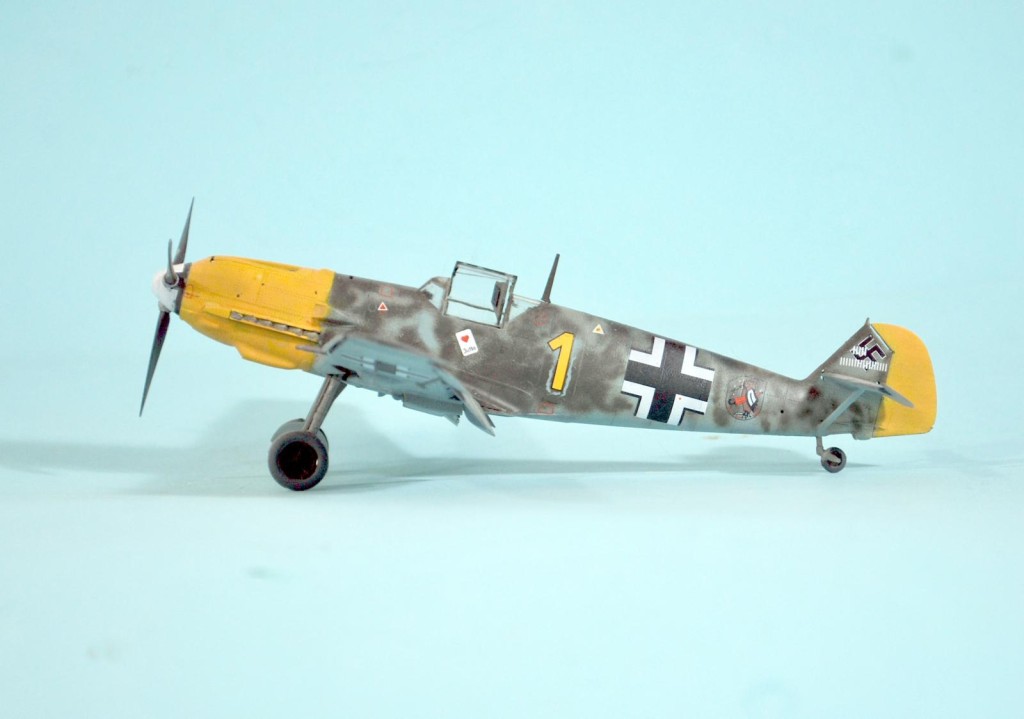
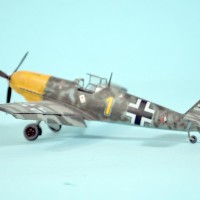
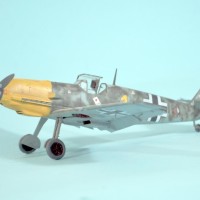
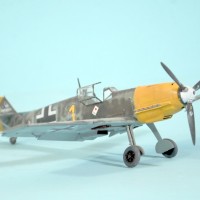
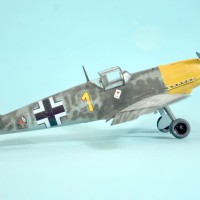
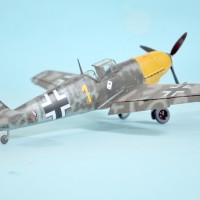
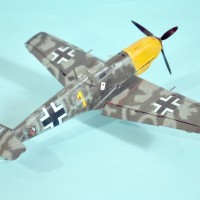
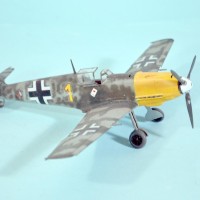
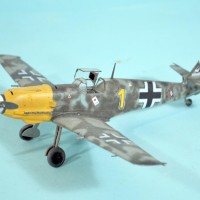
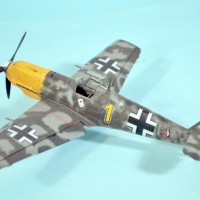
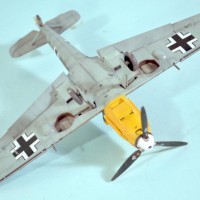

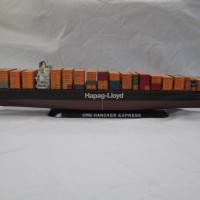
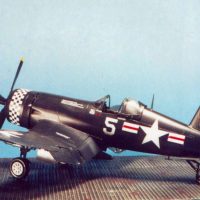
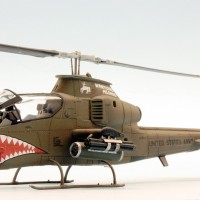
Nice build on your 109, plus great read.
Excellent build and great supporting article, Tom @tcinla
Personally I like those yellow nosed 109's the most and your build defintely shows why.
It is on my wish list now for sure.
Lovely job.
Beautiful Emil Tom !
Another fine product of your prolific labors, Tom.
Build and article, all excellent, Tom!
A worthy opponent to your growing model Spitfire squadrons !
Probably 68 to 1 , like the real event you described .
Great write up and model, as usual.
Great build and history, once again, Tom. I've always liked Priller ever since, as a 14 year old kid in 1962, I first saw his portrayal in "The Longest Day".
Great looking 109 Tom. I really like the camo scheme.
Beauty job on your Emil, Tom. Nice paint work with the camo scheme.
@tcinla - another great looking 109. I've got to add a Wingsy to my stash pile.
Nice! I did the Eduard version and wasn't that happy with the leading edge slats. They seemed too big.
That's because they ARE too big, @ross4. Too wide in chord by about 1/32 inch on the inborad end to slightly less at the wingtip (and not a "scale" inch - a real inch). It's why a standard-size upper wing cross decal for the Bf-109 won't fit. While that can be fixed - slice off the extra and glue it into the wing, add some putty and sand down - there are other dimensional problems to Eduard's kit that are unfixable. Comparing the fuselage to either a Tamiya, Airfix, or Hasegawa kit (which are acknowledged to be dimensionally accurate) the Eduard kit is too long in the rear fuselage and the cockpit is positioned too far aft. In fact, many of the problems of the Eduard Bf-109E are what was found in their first issue of the Bf-109G that caused all the screaming and yelling. But the Eduard "Emil" just continues on with nothing being noted or said.
The Wingsy kit is also the ONLY 109 kit of any sub-type that gets the area of the wing under the slat right, i.e., that there is no "ledge" there.
I also bult their 1/32 109E and with that the main problem was the complete lack of dihedral.
Another nice build and article - well done!